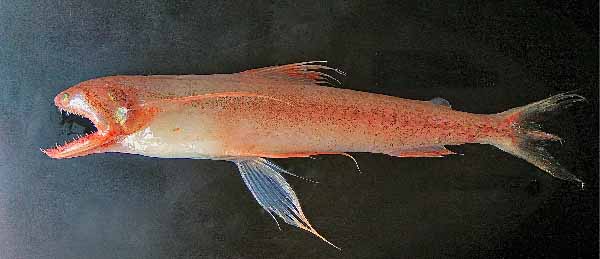Harpadon nehereus
(Hamilton, 1822)
|
Familie: Synodontidae SynonymeOsmerus nehereus Hamilton, 1822
Lokale Bezeichnung |
 Harpadon nehereus (Bay of Bengal, Bangladesh) -- (C) Sayedur R Chowdhury; FishBase; Creative Commons BY-NC 4.0 |
Typen
Keine Typusexemplare bekannt.
Siehe: Eschmeyer, W.N., Fricke, R. & Van der Laan, R. (eds.) 2024. Catalog of Fishes electronic version
Typusfundort: Botanischer Garten von Kalkutta, Mündung des Ganges, Indien.
Etymologie
Latinisierung von Nehare, seinem lokalen Namen an der Mündung des Ganges in Indien. (Übersetzt aus: The ETYFish Project)
Verbreitung
Indo-Westpazifik: Indien östlich bis zu den Salomon-Inseln, nördlich bis Südkorea und Südjapan.
IUCN Status

EX Extinct (ausgestorben)
EW Extinct in the Wild (in der Natur ausgestorben)
CR Critically Endangered (vom Aussterben bedroht)EN Endangered (stark gefährdet)
VU Vulnerable (gefährdet)
NT Near Threatened (potenziell gefährdet)
LC Least Concern (nicht gefährdet)
RE Regionally Extinct (regional oder national ausgestorben)DD Data Deficient (ungenügende Datengrundlage)
NE Not Evaluated (nicht beurteilt)
NT Near Threatened (potenziell gefährdet)
Gefahren für diese Art: Diese Art ist in mehreren Teilen ihres Verbreitungsgebiets überfischt, darunter Pakistan, Westindien, Bangladesch und China. Sie wird auch durch die Verschlechterung der Mündungsgebiete (d. h. Verschmutzung und Küstenentwicklung) beeinträchtigt, die in ihrem gesamten Verbreitungsgebiet vorkommt. In Digha, Indien, wurden hohe Konzentrationen von Schwermetallen gefunden.
Literatur
- Hamilton, F. 1822. An account of the fishes found in the river Ganges and its branches. Archibald Constable & Co., Hurst, Robinson & Co. Pp. i–vii + 1–405, Pls. 1–39. BHL Zitatseite [:209, 380 (als Osmerus neherius), !!, als Osmerus nehereus]
- Masuda, H., Amaoka, K., Araga, C., Uyeno, T. & Yoshino, T. (Eds.) 1984. The fishes of the Japanese Archipelago. Tokai University Press, Tokyo, xxii + 437 pp. Zitatseite [:62, Autor: Fujii , als Harpadon nehereus]
- Britz, R. 2019. Francis Hamilton's Gangetic Fishes in colour. A new edition of the 1822 monograph, with reproductions of unpublished coloured illustrationsillustrations. Edited, with an introduction and commentary by Ralf Britz. The Ray Society, London. 696pp. Zitatseite [:42, Pl. 118 (Hamiltons originale, zuvor unveröffentlichte Illustration)]
- Choi, S.-W-, Yu, H.-J. & Kim, J.-K. 2023. Comparative ontogeny and phylogenetic relationships of eight lizardfish species (Synodontidae) from the Northwest Pacific, with a focus on Trachinocephalus monophyly. Journal of Fish Biology, 104 (1)[2024]: 284-303. (First published: 25 October 2023). (doi) Zitatseite
- Zhang, Q., Sun, C.-H., Huang, X.-Y., Gu, Y.-L., Zhang, S.-H., Lao, Y.-L., Huang, J.-L. & Du, H.-W. 2024. Genetic diversity and population structure of the near threatened fish Harpadon nehereus in the Northwest Pacific: implications for conservation. Marine Biodiversity, 54: 9. (doi) Zitatseite